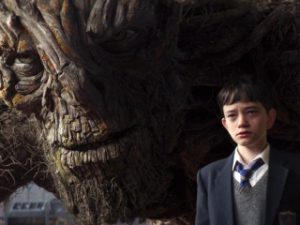A Monster Calls
Posted on January 5, 2017 at 5:50 pm

It turns out that there is something even more painful than the most devastating loss imaginable. That is the lesson of “A Monster Calls,” based on the Carnegie Medal and the Greenaway Medal award winning book by Patrick Ness, illustrated by Jim Kay, from an idea by the late human rights activist Siobhan Dowd.
It takes place in the Irish countryside. “We begin,” the movie tells us, “like so many stories, with a boy too old to be a kid and too young to be a man and a nightmare.” The boy is Conor (Lewis MacDougall), whose adored single mother (Felicity Jones) is struggling with cancer and the ravages of its treatment. While other boys are gently awakened by their parents and sent off to school with a good breakfast and a lovingly packed lunch, it is Conor who makes breakfast for his mother (there are rows of medicine bottles in the kitchen cupboard). He also does the laundry before he goes to school, where a bully threatens him. He has a frosty grandmother (Sigourney Weaver) and an affectionate but useless father (Toby Kebbell). So, he is alone with his grief, his fear, his anger, and his paints, which he must learn to use to express them all.
Let’s think for a moment about the title: “A Monster Calls.” Is that “calls” as in “pays a call,” or comes to visit? Is it “calls” as in “calls out to?” Is it “calls” as in “calls out from?”
A teacher says sympathetically, “If you ever want to talk…” Conor’s dad arrives from America, where he lives with his new wife and new baby, and he takes Conor to an amusement park. But Conor does not want to talk and he is not amused. A glimpse of the old “King Kong,” Fear and Fury bookends, and a shiver-inducing creaking noise give us a hint that a terrifying, destructive monster may be coming.
And then, yes, Conor is visited by a monster, an enormous walking yew tree with the rumbling voice of Liam Neeson. Conor may think the monster is there to protect him, but that is not exactly true. He says he is there to tell Conor three stories, and then, he says, Conor must tell him one and it must be true. The monster’s stories have a yew tree connection, as does a possible new treatment for Conor’s mother. They begin like traditional fairy tales but do not pretend that the resolutions are fair or straightforward. The fury within the stories seems to take over Conor and he finds himself becoming violent before telling his story forces him to admit what terrifies him even more than the prospect of losing his mother.
This is a complex, richly imagined film with a deep understanding, clear-eyed but compassionate. The stories it contains help us to be honest about our own.
Parents should know that this film is about a boy whose mother is dying of cancer. There are some other disturbing images and situations, including a bully and a monster.
Family discussion: Which story surprised you the most and why? Why was it important for Conor to tell his story? What monsters live inside us?
If you like this, try: the book by Patrick Ness and “Secondhand Lions”
